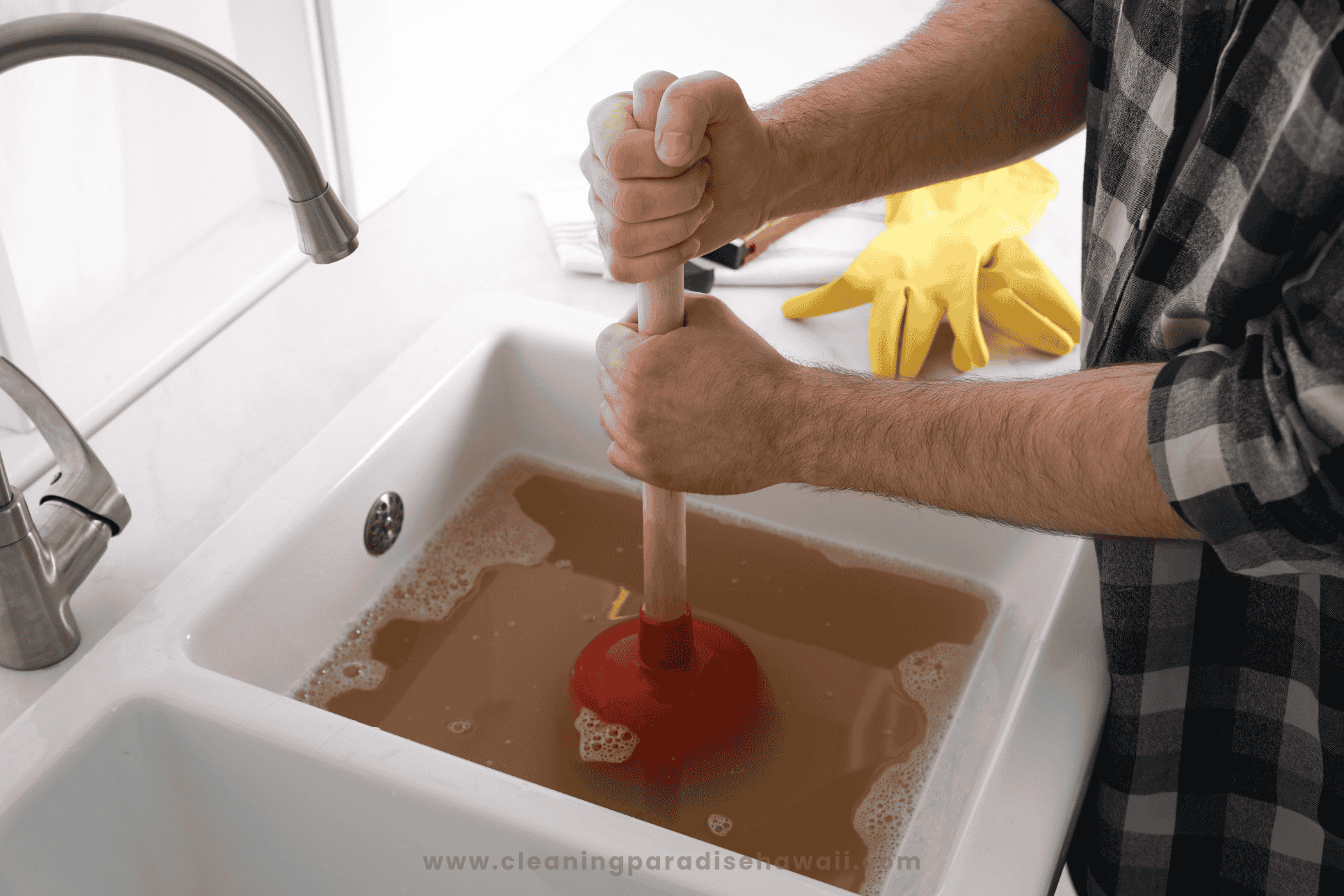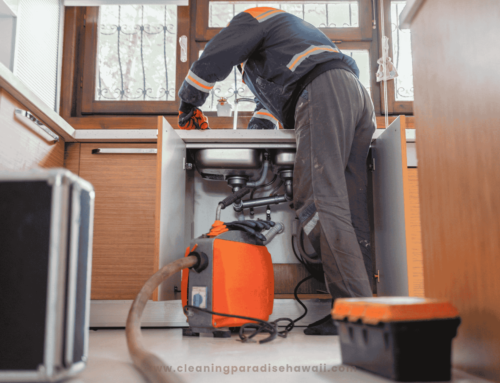
Keeping your kitchen sink drain clean is one of those household tasks that’s easy to forget—until you notice water draining slower than molasses or catch a whiff of something funky. Here in Hawaii, where the warm, humid climate can speed up bacterial growth and odors, maintaining a clean drain isn’t just about convenience—it’s about keeping your home fresh and pest-free.
Whether you’re cooking a big family luau meal or just rinsing tropical fruit pits down the disposal, food particles and grease can build up fast. The good news? With some simple, natural methods and regular maintenance, you can keep your kitchen sink flowing smoothly without resorting to harsh chemicals.
This guide will walk you through everything you need to know—from spotting early warning signs to step-by-step cleaning methods and preventative tips tailored for island living.
Why a Clean Kitchen Sink Drain Matters in Hawaii

Kitchen drains work hard every day, handling everything from coffee grounds to sticky rice and pineapple scraps. Over time, food debris, grease, soap scum, and mineral deposits from our water can build up inside pipes. Left unchecked, this gunk leads to:
- Slow drainage – Water pools in the sink instead of flowing freely
- Foul odors – Bacteria thrive in trapped food particles, creating that dreaded “rotten” smell
- Stubborn clogs – Grease hardens, and food scraps clump together, blocking water flow
- Pest problems – Fruit flies and ants love damp, food-filled drains
Hawaii’s warm, humid environment makes these issues worse. Bacteria multiply faster, and organic matter breaks down more quickly, meaning drains need attention more often than in cooler climates.
Regular cleaning prevents bigger headaches (and expensive plumbing bills) down the road. Plus, it keeps your kitchen smelling fresh—no one wants their home to smell like a backed-up drain when guests arrive for a backyard BBQ!
5 Warning Signs Your Drain Needs Cleaning

Catching problems early makes cleaning easier. Watch for these red flags:
- Water Drains Slower Than Usual
- If you notice water taking longer to disappear after washing dishes, buildup is starting.
- A completely blocked drain will leave standing water that refuses to budge.
- Unpleasant Odors
- A musty or rotten egg smell coming from your sink usually means decomposing food trapped in the pipes.
- These odors often get worse after running the garbage disposal.
- Gurgling Sounds
- Strange noises when water drains indicate air trapped in the pipes from a partial blockage.
- You might also hear bubbling when using the dishwasher if the drain is clogged.
- Visible Gunk Around the Drain
- Black or brown sludge around the edges of the drain is a clear sign of buildup.
- Food particles collecting in the strainer mean some are slipping past into the pipes.
- Fruit Flies or Drain Flies
- These tiny pests love breeding in the organic matter inside drains.
- If you spot them hovering around your sink, it’s time for a deep clean.
5 Effective Ways to Clean Your Kitchen Sink Drain
You don’t need expensive chemicals to tackle drain issues. These methods use common household items and work great for Hawaii homes:
1. The Boiling Water Method (Best for Grease)
Ideal for: Breaking down oily buildup from cooking
What you’ll need: A kettle or pot of boiling water
Steps:
- Boil 4-6 cups of water (enough to fill the drain pipe).
- Slowly pour about half down the drain, wait 30 seconds, then pour the rest.
- For tough grease, repeat once a week.
Hawaii Tip: Many island homes have PVC pipes—avoid boiling water if yours do, as it can soften the plastic over time.
2. Baking Soda & Vinegar (Deep Clean Power Combo)

Ideal for: Removing odors and breaking down organic gunk
What you’ll need: ½ cup baking soda, ½ cup white vinegar, hot water
Steps:
- Pour baking soda directly into the drain.
- Follow with vinegar—it will bubble up as it reacts with the baking soda.
- Let the mixture sit for 15-30 minutes to break down grime.
- Flush with very hot (not boiling) water to rinse everything away.
Why It Works: The chemical reaction helps loosen buildup, while both ingredients naturally deodorize.
3. Salt & Baking Soda Scrub (For Stubborn Buildup)
Ideal for: Scrubbing away sticky residue
What you’ll need: ½ cup salt, ½ cup baking soda, boiling water
Steps:
- Mix salt and baking soda in a bowl.
- Pour the mixture into the drain.
- Let it sit for 10 minutes to absorb odors and break down grease.
- Pour boiling water down the drain to rinse (unless you have PVC pipes).
Extra Boost: For extra cleaning power, use coarse sea salt, which acts as a gentle abrasive.
4. Manual Cleaning with a Drain Snake (For Tough Clogs)
Ideal for: Removing hair, food chunks, or solid blockages
What you’ll need: A drain snake or Zip-It tool ($3 at most hardware stores)

Steps:
- Insert the snake into the drain until you feel resistance.
- Twist and push gently to hook debris.
- Pull out the snake—you’ll likely find hair, food, or gunk stuck to it.
- Repeat until the drain is clear, then rinse with hot water.
Pro Tip: Wear gloves—this can get messy!
5. Enzyme Cleaners (For Ongoing Maintenance)
Ideal for: Regular use to prevent buildup
What you’ll need: An enzyme-based drain cleaner (like Green Gobbler or Bio-Clean)
Steps:
- Pour the recommended amount down the drain at night.
- Let it work overnight—the enzymes eat away organic matter.
- Flush with water in the morning.
Why It’s Great: Safe for all pipes and septic systems, with no harsh chemicals.
Preventing Clogs: Hawaii-Friendly Habits
An ounce of prevention is worth a pound of cure, especially with plumbing! Adopt these habits to keep drains clear:
✔ Use a Drain Strainer – Catches food scraps before they go down. Look for fine mesh ones that fit your sink.
✔ Dispose of Grease Properly – Never pour oil down the drain. Let it cool, then toss it in the trash or recycle it (some locations accept cooking oil for biodiesel).
✔ Rinse with Hot Water Weekly – Helps prevent grease buildup.
✔ Grind Ice Cubes Monthly – Toss a handful of ice cubes + 1 tbsp salt into the garbage disposal to sharpen blades and knock off gunk.
✔ Avoid Starchy Foods in Disposal – Pasta, rice, and potato peels expand in pipes, causing clogs.
When to Call Cleaning Paradise Hawaii
While most clogs can be handled at home, some situations need a pro:
🚨 Water won’t drain at all – If plunging and snaking don’t work, there may be a deep clog.
🚨 Recurring blockages – Could indicate tree roots in outdoor pipes or a collapsed line.
🚨 Multiple slow drains – Suggests a main sewer line issue.
🚨 Foul smells persist – May mean a broken pipe or vent stack problem.
Our team services all islands with eco-friendly, effective solutions—just give us a call!
Final Thoughts
A little regular maintenance keeps your kitchen sink drain—and your whole home—fresh and functional. By using these simple, natural methods, you can avoid most clogs and odors without harsh chemicals.
Remember, in Hawaii’s climate, drains need a bit more attention than in cooler places. Stick to a routine, and your sink will thank you!
For more cleaning tips or to schedule service, visit Cleaning Paradise Hawaii. Now go enjoy that beautiful island breeze—with one less household worry! 🌺




